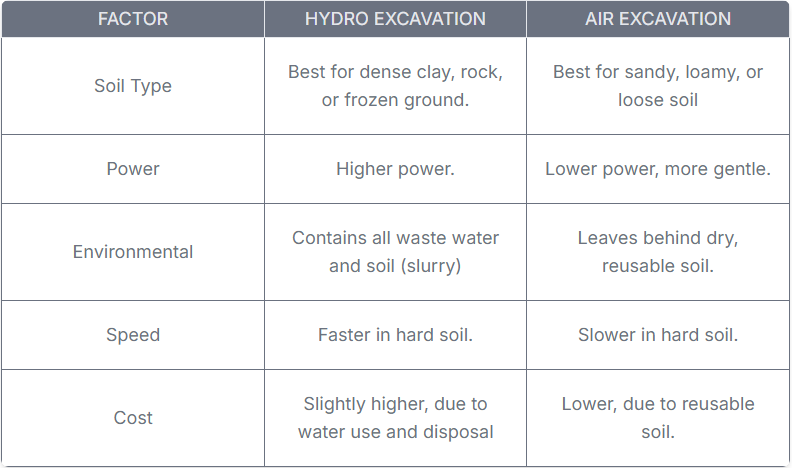Ultimate Guide to Non-Destructive Digging: Hydro vs. Air Excavation
When a construction project requires exposing underground utilities, the old days of using a backhoe are gone. Today, non-destructive digging is the industry standard for safety and precision. The two most effective methods are hydro excavation and air excavation. While both use pressurized streams and a powerful vacuum to safely clear soil, they are not interchangeable. This guide will walk you through the key differences, benefits, and applications of each to help you determine which method is best for your project.
What is Hydro Excavation?
Hydro excavation uses a highly pressurized stream of water to break up soil. As the water stream cuts through the ground, a powerful vacuum hose immediately sucks up the resulting slurry (a mixture of soil and water) into a debris tank on the truck. This method is incredibly effective at cutting through tough, compacted clay, rocky soil, or even frozen ground. The precision of the water stream allows for careful and controlled excavation around sensitive utilities, and the vacuum system ensures the job site remains clean.
The Benefits of Hydro Excavation
Power & Efficiency: It's the most powerful non-destructive method, making it ideal for large-scale projects or challenging soil conditions.
Speed: It is often faster than air excavation, especially in dense soil.
Cleanliness: The process contains all of the spoils in a self-contained debris tank, minimizing mess on the job site.
What is Air Excavation?
Air excavation uses a high-pressure stream of air to loosen soil. A powerful vacuum hose then removes the loosened, dry soil and debris. Because it uses air instead of water, it is a great choice for areas where water could cause a problem, such as around sensitive electrical conduits or when you need to immediately backfill the hole with the same dry soil. Air excavation is highly effective in sandy or loamy soil and is known for its delicate touch.
The Benefits of Air Excavation
No Slurry: Since no water is used, there is no wet slurry to dispose of, making it a faster process from start to finish.
Less Invasive: The air stream is more gentle, making it perfect for working around delicate or older utilities.
Reusable Soil: The dry soil can often be used immediately for backfilling, eliminating the need to bring in new fill material.
Hydro vs. Air: Which is Right for Your Project?
The best choice between hydro excavation and air excavation depends entirely on the specifics of your project. Here is a simple breakdown to help you decide:
Why You Need a Professional Utility Contractor for Non-Destructive Digging
While the principles of these techniques are straightforward, their successful application requires the expertise of a professional utility contractor. Our team at US Utility Potholing & Air Excavation has the knowledge and specialized equipment to handle either method, ensuring you get the right solution for your project. We understand the specific soil conditions across South Florida and the regulations required to keep your project on track, on budget, and most importantly, safe.
Contact Us for a Safe & Accurate Project
Whether you need the brute force of hydro excavation or the gentle touch of air excavation, our team is ready to provide the best solution for your project. Contact us today for a free consultation and let us help you achieve pinpoint accuracy with our non-destructive digging services.


